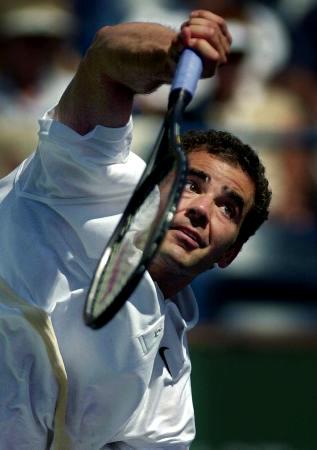To the OP: Forget about practicing your 1st serve for a while. The best thing that you can do for your first serve is to develop a solid/reliable spin (2nd) serve.
More about proper serve mechanics:
Make sure that you are not muscling or "arming" the ball -- do not rely solely/primarily on your shoulder to generate racquet head speed. Your grip and your arm should be fairly relaxed for most of the serve motion. (Refer to post #40 regarding the proper grip size). Too much tension in the hand, arm, and shoulder can be overly stressful to your arm/shoulder.
Try to use some leg drive (bend your knees at least a bit) if you are trying to generate more racquet head speed. If you are not ready for the knee bend and the leg drive, then stick with a moderate pace on your serves.
Do not rush your windup or racket preparation. You can even start from the trophy position if you are rushing the prep or if the takeback/windup is creating hitches in your serve motion. Make certain that your trophy position is correct and you execute an adequate racket head drop from that trophy.
The trophy should have some shoulder tilt and the elbow (or the racket arm) should be directly in line with that shoulder tilt. (See image below). The elbow should not move much above the shoulder line -- doing so places excessive stress on the shoulder. Take a look at the link of Sharpova's trophy position. Her elbow is slightly above the shoulder line in this image. This
slight "flaw" might not really be too bad. However, many servers let the elbow come up quite a bit more above the shoulder line on the trophy or during the racket head drop. This is
not good for the shoulder at all.
http://www.optimumtennis.net/images/improve-tennis-serve.jpg
As the racket head is dropped, the vertical tossing arm also starts to come down. The shoulder line becomes horizontal (parallel to the court surface) as the front shoulder drops (and the back shoulder moves upward with the racket head drop). The elbow should still be in line with the shoulders. Note that body had been coiled for the toss and the trophy position. As the serve motion continues from the trophy, the body uncoils and a shoulder-over-shoulder cartwheel action is employed. These actions should help to minimize stress to the shoulder.
As the serving arm reaches upward to hit the ball, the front arm and shoulder should be pulled down so that the shoulders have a reverse tilt. The elbow is still pretty much in line with the shoulders at this point. Take a look at the middle image of Andy Roddick in the link below:
http://www.optimumtennis.net/images/andy-roddick-serve.jpg
Take a look at how Sampras bends his elbow on his follow-thru after contacting the ball in the 2 images below. This action probably helps to alleviate stress to the arm and shoulder on the follow-thru.
http://www.tennisserver.com/turbo/images/turbo_03_12/Sampras7.jpg





